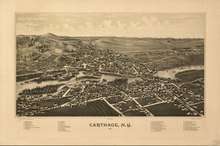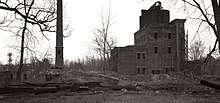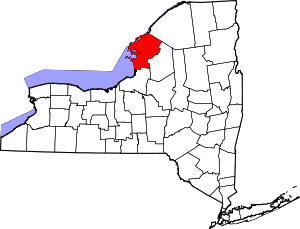Carthage, New York
Carthage is a village located in the town of Wilna in Jefferson County, New York, United States. The population was 3,747 at the 2010 census.[3] The village is named after the historic city of Carthage in Tunisia.
Carthage, New York | |
|---|---|
Village | |
 Carthage  Carthage | |
| Coordinates: 43°58′52″N 75°36′25″W | |
| Country | United States |
| State | New York |
| County | Jefferson |
| Town | Wilna |
| Area | |
| • Total | 2.59 sq mi (6.71 km2) |
| • Land | 2.42 sq mi (6.28 km2) |
| • Water | 0.16 sq mi (0.42 km2) |
| Elevation | 768 ft (234 m) |
| Population (2010) | |
| • Total | 3,747 |
| • Estimate (2019)[2] | 3,289 |
| • Density | 1,356.29/sq mi (523.60/km2) |
| Time zone | UTC-5 (Eastern (EST)) |
| • Summer (DST) | UTC-4 (EDT) |
| ZIP code | 13619 |
| Area code(s) | 315 |
| FIPS code | 36-12683 |
| GNIS feature ID | 0969965 |
| Website | www |
The village of Carthage is along the southern border of the town of Wilna and is east of Watertown.
History
The original settlement was called "Long Falls" and was first settled around 1798.

The village was chartered in 1869.[4] It is one of only twelve villages in New York still incorporated under a charter, the other villages having incorporated or re-incorporated under the provisions of Village Law.[5]
In 1861, a major fire destroyed about twenty buildings in the village, and a smaller fire at the end of the year destroyed more property. A somewhat less destructive fire occurred in 1872. Another large fire in 1884 spread across the river from West Carthage and caused extensive damage, reducing more than 150 buildings to ruin. The First Baptist Church and Cook Memorial Building, State Street Historic District, and United States Post Office are listed on the National Register of Historic Places.[6] In 2002, another fire destroyed eight buildings in the downtown area, displacing nearly 150 residents and leaving a pile of ruin.
Notable people
- Carla Balenda, film and television actress, born in Carthage in 1925
- John Carpenter, film director, screenwriter, and producer
- Clay DuMaw, film director, screenwriter and producer. He is best known for his work on Hold 'em and Get Out Alive
- Casey Powell, Ryan Powell, and Mikey Powell, All-American lacrosse players at Syracuse University and professional Major League Lacrosse players.
- Dave Trembley, Major League Baseball coach, manager and executive
Geography
Carthage is located in eastern Jefferson County at 43°58′52″N 75°36′25″W (43.981118, -75.606849).[7] Its southwestern border is the Black River, which is in part the border with the town of Champion and the village of West Carthage in Jefferson County, and in part the border with the town of Denmark in Lewis County. The village is 2 miles (3 km) south of the southern border of Fort Drum.
According to the United States Census Bureau, the village has a total area of 2.7 square miles (6.9 km2), of which 2.5 square miles (6.5 km2) are land and 0.2 square miles (0.4 km2), or 6.35%, are water.[3]
The village is located at the junction of New York State Routes 3 and 126. NY-3 leads west 18 miles (29 km) to Watertown, following the Black River, and northeast 20 miles (32 km) to Harrisville. NY-126 leads west by a more direct route 16 miles (26 km) to Watertown and southeast 14 miles (23 km) to Croghan.
Media
Champion Hill, located between Carthage and Watertown, is the birthplace of the majority of Watertown local TV stations. It hosted the original facilities for WWNY-TV (1954–1970) and later WPBS-TV (as WNPE, 1971–1977). WWNY's city of license still officially names Carthage, even though WWNY's studios have now moved to downtown Watertown.
Demographics
| Historical population | |||
|---|---|---|---|
| Census | Pop. | %± | |
| 1840 | 600 | — | |
| 1850 | 700 | 16.7% | |
| 1860 | 1,500 | 114.3% | |
| 1880 | 1,912 | — | |
| 1890 | 2,278 | 19.1% | |
| 1900 | 2,895 | 27.1% | |
| 1910 | 3,563 | 23.1% | |
| 1920 | 4,320 | 21.2% | |
| 1930 | 4,460 | 3.2% | |
| 1940 | 4,207 | −5.7% | |
| 1950 | 4,420 | 5.1% | |
| 1960 | 4,216 | −4.6% | |
| 1970 | 3,889 | −7.8% | |
| 1980 | 3,643 | −6.3% | |
| 1990 | 4,344 | 19.2% | |
| 2000 | 3,721 | −14.3% | |
| 2010 | 3,747 | 0.7% | |
| Est. 2019 | 3,289 | [2] | −12.2% |
| U.S. Decennial Census[8] | |||
At the 2000 census,[9] there were 3,721 people, 1,417 households and 956 families residing in the village. The population density was 1,480.4 per square mile (572.4/km²). There were 1,626 housing units at an average density of 646.9 per square mile (250.1/km²). The racial makeup of the village was 91.32% White, 4.27% African American, 0.21% Native American, 1.05% Asian, 0.05% Pacific Islander, 1.10% from other races, and 1.99% from two or more races. Hispanic or Latino of any race were 2.69% of the population.
There were 1,417 households of which 36.0% had children under the age of 18 living with them, 49.1% were married couples living together, 14.9% had a female householder with no husband present, and 32.5% were non-families. 27.2% of all households were made up of individuals and 12.6% had someone living alone who was 65 years of age or older. The average household size was 2.53 and the average family size was 3.08.
Age distribution was 28.3% under the age of 18, 9.0% from 18 to 24, 28.6% from 25 to 44, 19.6% from 45 to 64, and 14.5% who were 65 years of age or older. The median age was 34 years. For every 100 females, there were 91.1 males. For every 100 females age 18 and over, there were 84.9 males.
The median household income was $23,583, and the median family income was $32,083. Males had a median income of $31,397 versus $18,713 for females. The per capita income for the village was $13,029. About 18.6% of families and 23.5% of the population were below the poverty line, including 33.9% of those under age 18 and 14.4% of those age 65 or over.

See also
- Carthage, South Dakota, named after Carthage, New York
References
- "2019 U.S. Gazetteer Files". United States Census Bureau. Retrieved July 27, 2020.
- "Population and Housing Unit Estimates". United States Census Bureau. May 24, 2020. Retrieved May 27, 2020.
- "Geographic Identifiers: 2010 Census Summary File 1 (G001): Carthage village, New York". American Factfinder. U.S. Census Bureau. Archived from the original on February 13, 2020. Retrieved September 7, 2018.
- "Welcome to the Village of Carthage NY 13619". villageofcarthageny.com. Retrieved 2017-01-25.
- "Local Government Handbook - Village Government: Historical Development" (PDF) (5th ed.). New York State Department of State. 2008. pp. PDF page 72. Archived from the original (PDF) on 2010-02-15. Retrieved 2009-06-26.
- "National Register Information System". National Register of Historic Places. National Park Service. March 13, 2009.
- "US Gazetteer files: 2010, 2000, and 1990". United States Census Bureau. 2011-02-12. Retrieved 2011-04-23.
- "Census of Population and Housing". Census.gov. Retrieved June 4, 2015.
- "U.S. Census website". United States Census Bureau. Retrieved 2008-01-31.
